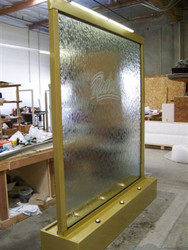The Science and Art of Wall Mounted Waterfalls
22nd Jan 2024
Wall fountains are more than simply beautiful ornaments; they are amazing pieces of art that deftly blend science and art. If you're drawn to the alluring allure of wall-mounted waterfalls, knowing how they work can make you enjoy these fascinating water features even more.
Anatomy of a Wall Fountain
Let's examine the essential parts of wall fountains in order to solve the puzzle of how they operate:
Water Pump:
The main part of a bubble wall fountain is the water pump, which is the engine that raises and lowers the water. Pump sizing is critical to ensuring a steady and effective water flow. A poorly chosen pump ensures optimal performance, while an ill-fitting pump could put the system as a whole in danger.
Water Reservoir:
The water reservoir must be big enough to hold the necessary water volume and robust enough to withstand water pressure. The reservoir must be conveniently accessible in order to be maintained and repaired.
Tubing:
Tubing acts as the conduit to carry water from the reservoir, through the pump, and up to the fountain's nozzle. PVC and rubber are robust, pliable materials that are excellent for tubing. A smooth and effective water flow is ensured by correctly attaching the tubing to the pump and nozzle.
How Do Wall Fountains Work?
The way the water pump and reservoir work together determines how wall fountains work. Water is circulated by the pump from the reservoir to the fountainhead, where it falls over the wall. After that, the water goes back into the reservoir to start the cycle over. The pump is managed by a straightforward switch, allowing you to set the fountains on and off times. Wall fountains may even capture solar energy with very little electrical usage, which makes them an economical and environmentally beneficial option.
Installation of Wall Fountain
To really embrace the peace that wall-mounted waterfalls offer to an area, careful installation is required:
Finding the Right Location:
Select a spot that will allow for easy access and visibility while maintaining a calm environment. Aspects such as wind direction and sunlight should be taken into account since they might affect the whole experience. Make sure the fountain is complemented by the surrounding area, including any other plants and furnishings.
Installing the Pump and Tubing:
It is essential to position the pump correctly and connect the tubing securely. To ensure smooth water flow, the tubing needs to be free of air pockets and the pump positioned strategically to pull water from the reservoir. After installation, just fill the fountain to make it magical.
Securing the Fountain:
Because safety is the first priority, firmly fasten the fountain to the wall or other structure. Make use of a wall mount or anchor suitable for the weight of the fountain. By tethering the fountain, any unintentional movement during operation is prevented and stability is ensured.
Adding a bubble wall fountain to your outdoor or indoor environment adds the calming presence of flowing water in addition to improving its aesthetic appeal. Wall mounted waterfalls have an appealing charm that may turn your surrounds into a peaceful refuge with only a simple understanding of their physics.

